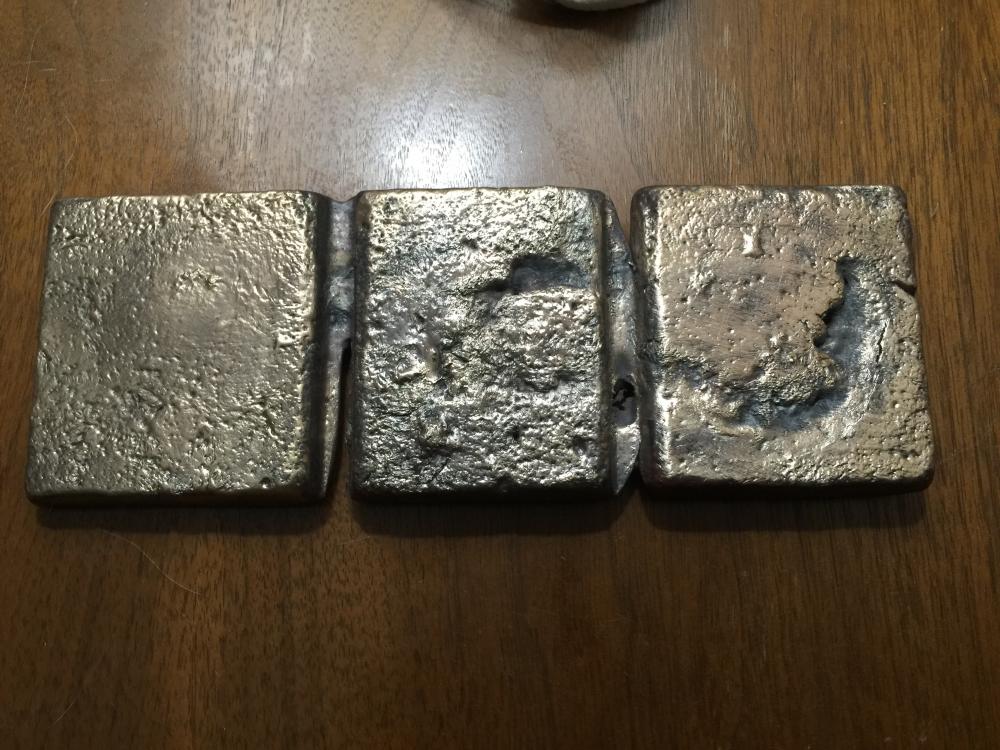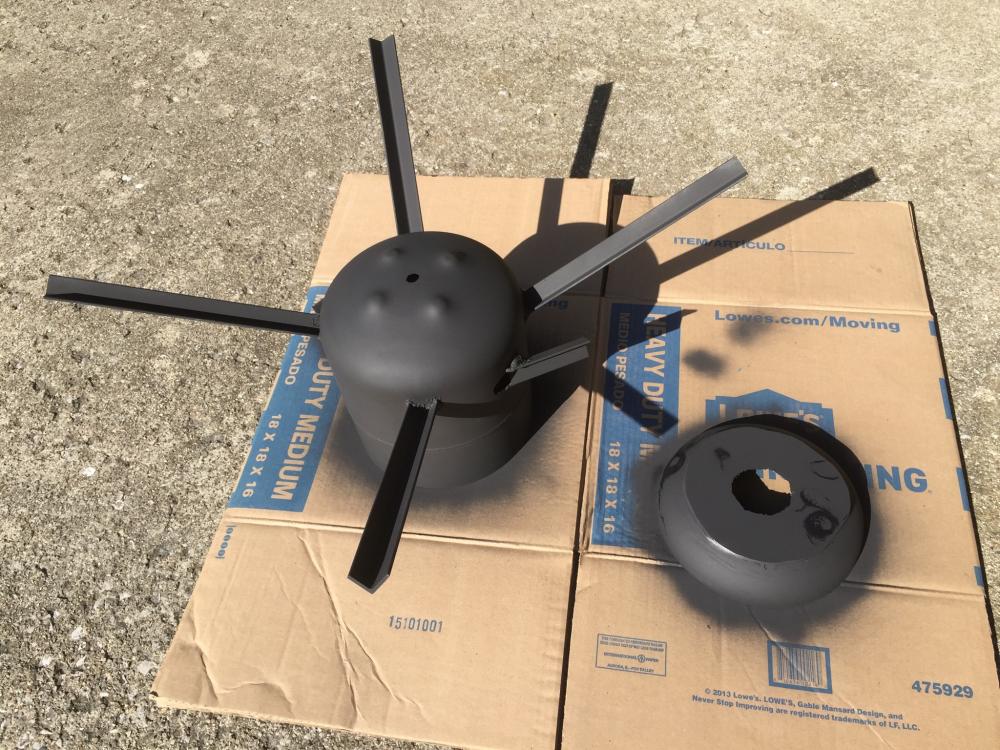-
Posts
59 -
Joined
-
Last visited
Content Type
Profiles
Forums
Articles
Gallery
Downloads
Events
Everything posted by David Durman
-
Here is a 3M chart to figure what type of mask you need for different types of work if you want to go with disposables; a simple painter's mask isn't going to do much. I would invest in a respirator; it isn't too much more expensive than an appropriate disposable, just make sure you have the right kind of cartridges.
-
From what little I recall from documentaries, I remember that gold mining consumes a lot of mercury. I think, from looking around the class I took, watching casting and blacksmithing videos online, and elsewhere, since a lot of the terrible things are invisible gases, it is really hard to get people to seriously worry about them; getting people to wear a respirator around casting seems as hard as getting small time contractors to wear hardhats on a construction project.
-
No, I would expect most people would respond with a questioning look about 'volatilized' and would say, "Mercury's kinda sorta dangerous, right? They use to let us hold it in our hand when I was in elementary school". Coupling that with how good people are at talking themselves into something they want to do, it wouldn't be hard to imagine someone trying their hand at fire-gilding with an ersatz hood or even not one at all.
-
Fire gilding? Wow, indeed. Do you have any more detail on how that went, or a link? I'm mostly curious since I don't have a hood, but I'm going to be doing gilding with transfer leaf at some point in the coming months and am curious as to the comparison.
-
I think you have greatly misinterpreted Frosty's intent and have read things into what he said. Frosty's concern stems from the fact that overconfident amateurs that end up horribly disfiguring or crippling themselves, especially with casting, has been so common in this hobby (and the professionals for that matter) that it is a cliché. It's not a matter or question of your intellect; the learning curve on the basic skill sets do not allow for too many, if any, mistakes. I myself am an amateur and I can tell you that if I hadn't taken the class I did, as little time as it spent on casting specifically, I would have probably done serious permanent harm to myself. I still have a great deal of trepidation approaching any pour (not that I have too many), even the small silver castings I'm doing on my workbench. Your mold design has all of the critical flaws that he pointed out no question and certainly shouldn't be lost-foam, but I'm not surprised too much that it worked (sort of) one time, or even ten times; it's not that improbable to flip a coin to heads a bunch of times in a row. Eventually, however, the flaw is going to express itself. The behavior that concerns people on here is that you designed this mold system and utilized it multiple times without checking it first with anyone experienced; you could post it on here, take it to a welding shop and see if anyone can help, find a farrier shop, a local foundry or blacksmith if you are lucky, or just get some kind of second opinion. Something would be better than nothing if for no other reason than to walk through your thinking out loud. I worked on a drill rig for a large portion of my 20s and I never met a driller that wasn't missing at least part of a finger; I still have all mine probably because all of those missing fingers made me very cautious. This is something you need to be doing with the utmost caution.
-
I would be concerned about the clay content of your sand (if I recall correctly, that play sand is going to have little not no clay, or is at least not very consistent). I got this book for my Kindle and it seems pretty good, although I haven't had too much time to read it. It talks about sand types for different metals.
-
Well, let's go through some of your setup and see if we can figure out the issue. What are you using for your sand? Better yet, do you have a picture(s) with your mold already made and your sprues cut into it? Walk us through your pour procedure; how long past melt are you letting your crucible sit in the foundry (overheating is a serious concern with bronze)? Do you have a picture of your dross (I'm not sure what you mean by not a lot)? More information will help someone smart, like Thomas, figure out what could be the issue. As it stands, I would agree that it is possibly a degassing issue; I've never had a degassing issue with bronze but 1) I haven't done too much bronze casting and, 2) I always use a handful of crushed charcoal so I've never actually seen if there is an issue when doing a straight casting.
-
I had success with degassing copper/bronze by throwing in a handful of crushed charcoal and letting it burn for a minute before pouring. It worked well enough, but as I understand it there are better fluxes you can use but bronzes general shouldn't need much degassing if any, and aluminum doesn't need any at all. An interesting method someone told me was to put in some glass after your metals; the glass melts and floats to the top, sealing your metal away from the air. When you go to pour you just break the glass. I don't really think, though, that would need much beyond some crushed charcoal. Based on what you are saying, I would be largely concerned with the providence of your metals. If you are confident that they are fairly pure, then I would suggest cleaning them thoroughly prior to melting. The professor I had in my class will tell you all day about how temperamental aluminum is in regards to cleanliness. Is there any particular reason that you want to go with an aluminum bronze aside from that simply being the materials you have on hand, if I may ask? If all else fails, you can go the more expensive route of ordering copper bullion so you can eliminate it as a contaminant candidate.
-

Protecting the foundry
David Durman replied to David Durman's topic in Smelting, Melting, Foundry, and Casting
When I spoke with the place I'm planning on buying the refractory from the guy on the other end said just to ask when I get there if there is any scrap kaowool in the dimensions I need and they will just give it to me since they only sell it in giant rolls, so there isn't really any cost difference for me between kaowool and the refractory I'm buying anyway. You are right, though, I am probably overthinking it. -

Protecting the foundry
David Durman replied to David Durman's topic in Smelting, Melting, Foundry, and Casting
I see; I thought you were referencing something in those plans rather than your previous post, for some reason. Thanks! EDIT: Assuming I want to go with kaowool to save on fuel, and that humidity is relatively high where I am, do you still think that it wouldn't be worth it to paint the interior wall of the foundry? -
When I made that bronze I ordered these tin ingots off of ebay and order 2 Two Pound Copper Bullion Ingots from Provident Metals. Certainly not the cheapest method.
-

Protecting the foundry
David Durman replied to David Durman's topic in Smelting, Melting, Foundry, and Casting
Save hundreds seems unlikely unless the castable refractory I'm considering buying isn't sufficient; I suppose he could mean over the course of relining the foundry. I'm planning on using U.S. Refractories Lou Cast 3000, which seems like it is up to the task. -

Propane tank foundry
David Durman replied to krossbones's topic in Smelting, Melting, Foundry, and Casting
Additionally, I was told that even if a tank is 'brand new' and empty, it is certainly possible that the manufacturer's quality control involves filling the tanks with propane to test them, so there could be residue in them.- 12 replies
-
Thomas is right; just buying silicone bronze is going to be the easiest, but since this is a decorative piece then you will probably be more satisfied with making your own bronze so you can control the color. Thomas's 90:10 mix is by far the most common alloy, and probably what would be most commonly thought of as a bronze color. My 87.5:12.5 is going to give you that blonde color while mixes closer to 92:8 are going to give you a redder, darker color. The typical range I've seen for 'bronze' is 8-12% tin, but of course there are all sorts of other bronzes you can make if you are looking for a specific color. I would look up different bronze types and look at the images to find the color you want; statuary bronze for example is 97 Cu:2 Sn:1 Zn, but I would strongly caution against using any Zinc or Lead in your mix unless you can get some experienced supervision since both are potentially toxic. If you do decide to order some type of bronze rather than making it pay special attention to its alloy composition.
-
Fair enough. I was merely suggesting the 12.5% tin bronze because I like the color and he specified that this is a purely decorative piece.
-

Propane tank foundry
David Durman replied to krossbones's topic in Smelting, Melting, Foundry, and Casting
Just to add what I had been told, the process is essentially what natenaaron said, except that liquid detergent should be added to the water solution. I was also told that, after the valve has been removed but prior to the rinses, it should be hung upside down for about a month. It just seems like too much hassle; I bought a helium tank from Target for $20, emptied the helium, and used it immediately. That tank is a temporary tank as per the USDOT specification, but I actually got in touch with a materials engineer at the manufacturer and he said that (very unofficially) it is fine for foundry use as he used one for the same purpose.- 12 replies
-
I recently made some bronze with 12.5% tin and rather like the high blonde color I got out of it. EDIT: Might help if I attached the picture. This is a very rough polish, mostly just to remove scale.
-

Protecting the foundry
David Durman replied to David Durman's topic in Smelting, Melting, Foundry, and Casting
Thanks! I was fairly certain I was being overly cautious with the paint, but it seemed a pretty inexpensive step and the annual humidity here is 70. I'm thinking that I will use refractory on the walls as well; I'm not sure why those plans are calling for kaowool on the walls, but it seems like there shouldn't be an issue with refractory. -
I'm putting together a home foundry following some plans, but they haven't discussed the subject of high heat paint to protect the steel of the body and I was hoping someone here would have some insight. I've roughed out the body of my foundry and coated the outside with high heat paint (see attached) to prevent the steel from oxidizing; the paint is rated up to 2000F and my thinking was that if the exterior gets to the point of 2000F then I have bigger problems than paint vaporizing. I am tempted, however, to paint the inside wall as well; the lid and the bottom will be protected from oxidation by the refractory I plan to line them with, but the walls are simply going to use kaowool to contain the heat and I am worried that if I paint the interior that I could be risking temps that will vaporize the paint, especially at the seam of the kaowool. I really want to protect the steel as much as possible to extend the life of the foundry but I draw the line at any safety risks. I've considered lining the walls with refractory as well, but I am very reticent to deviating from plans. Here are the plans I'm using for reference. Any advice would be greatly appreciated. Additionally, I am planning on buying a burner rather than constructing one as per the plans; I'm certain that I could make one but there are practical concerns and I like the craftsmanship of the burners I'm eyeing in eBay. These plans are for a burner where the tube is 3/4", but I think I can manage to attach something with a 1" tube as I can't seem to find any made to the specifics of the Reil EZ burner that the plans call for; would this be too much for this small a foundry? I could obviously just turn it down, but I would prefer to not over-stress what I'm working with. Thanks again; these forums have been a lot of help.
-

Greensand Mold Lifespan
David Durman replied to David Durman's topic in Smelting, Melting, Foundry, and Casting
That's a good idea, too; Thanks! I'm not sure if I'll have time for that, though. If we agree next class on a time for me to come back I will give that a try. -

Greensand Mold Lifespan
David Durman replied to David Durman's topic in Smelting, Melting, Foundry, and Casting
Thanks! Good to know. i also just noticed that the word 'gild' was autocorrected to 'gold'. -

Greensand Mold Lifespan
David Durman replied to David Durman's topic in Smelting, Melting, Foundry, and Casting
I stupidly didn't think of that; I was just counting individual objects. I'm not sure if I can combine patterns into the same flask, though; two of them are using the same pattern so that is two flasks, one is using a 12.5% tin bronze I mixed up separate, and the remaining two are boxes that will need, as I understand it, complex spruing to avoid failure. Yes, I'm the one planning on making the bronze Jewelry Box (2 actually, one for each of my daughters). The dimensions have changed because I ran out of time to carve them from pine and just bought a couple of generic boxes from a craft store for my pattern. The walls are about 1/8" thick, which is good, but I'm worried about the bottom since it looks to be 1/32", although I can probably just fix that with some plasticine. My long term goal with them is inlay silver wire into the grooves and to etch them at home with flowers, then use gold and silver loose leaf to gold the etching. It'll be pretty depressing if I don't get to cast them. -

Greensand Mold Lifespan
David Durman replied to David Durman's topic in Smelting, Melting, Foundry, and Casting
Smoggy - That is my hope, but the class is only 3 hours; I have 5 molds to make, one of which has to use the same pattern so presumably I would make that one first so I can get the pattern out us it again within the timeframe. Thomas - I discussed it with him briefly last night (the class is on Thursdays); he said we can talk about it next class (the last one for me) and maybe get me in there on a Saturday or something. It was vague enough to cause concern so I'm trying to figure out a workaround. -

Greensand Mold Lifespan
David Durman replied to David Durman's topic in Smelting, Melting, Foundry, and Casting
Fair points. Looking at the weather, the humidity is projected to hover around 40%, so not particularly good. Do you think that it would have a 'sweating' problem if I sealed it up? I thought about the vibration from the transportation, but I don't know how to counter it if it is even practically possible. Do you think a different method that greensand would work? -
I have a question concerning the longevity of a greensand mold, specifically what is the maximum time period I can make them in advance of casting before they begin to crumble? I am taking a metal working class at my local university and, due to time constraints, I only have 1 class left and I am worried that I am not going to be able to cast my bronze projects. It occurred to me that I could make my molds at home and then cast them at my last class, but I am concerned about the molds drying out beforehand; could I coat the outside in parting dust and plug the risers to prevent dry out? Thanks for any help.


